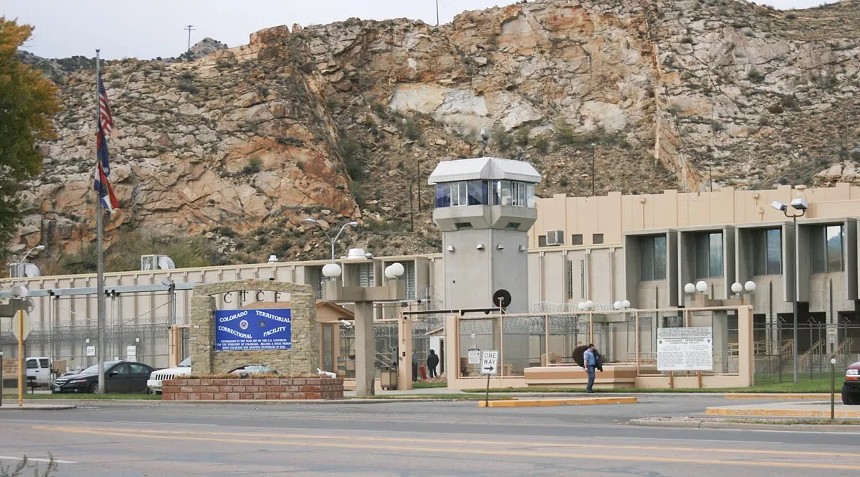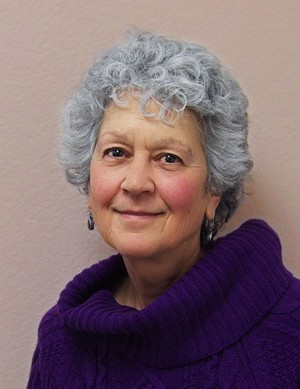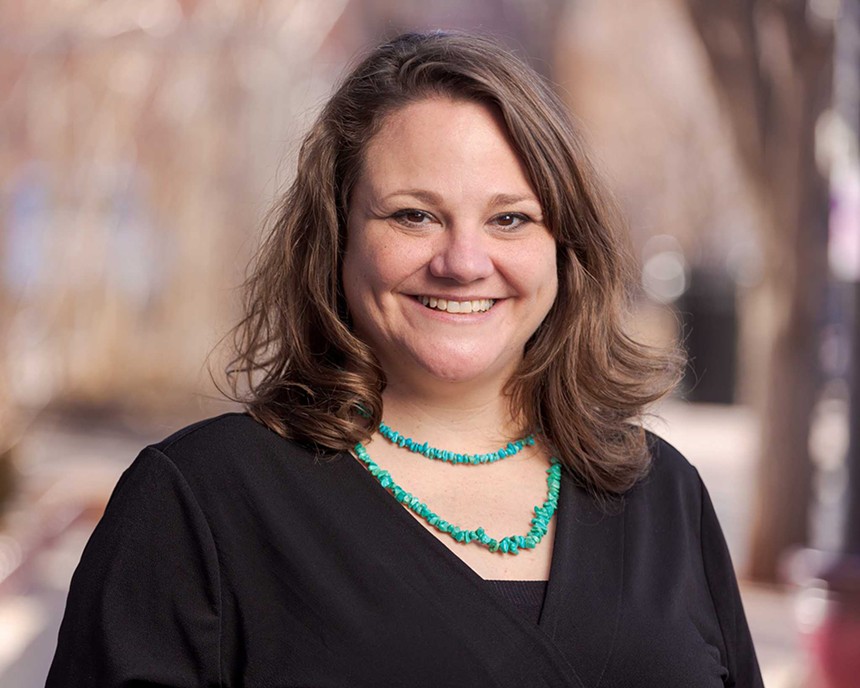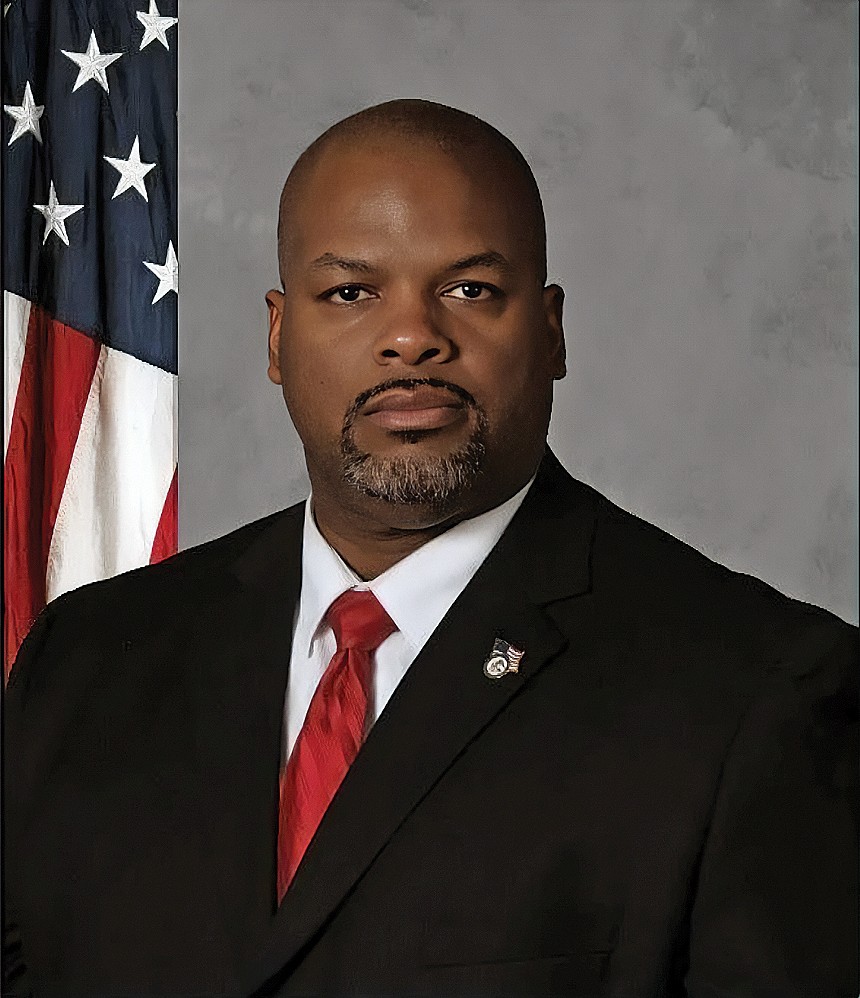Like many people working inside prisons today, Dana Mueller didn’t start out planning to pursue a career in corrections. Eight years ago, she was working for a nonprofit and working on a master’s degree in social work when she saw a job listing for a case manager at the Colorado Department of Corrections.
Mueller wasn’t interested in being a jailer. But the opening was on the administrative side of the operation: A case manager helps offenders complete required programs and prepare for parole so that they’re less likely to commit additional crimes after release. It was a mission that appealed to Mueller for several reasons.
“My goal is to do whatever I can to make a positive difference, no matter how small, to reduce the potential for future victims,” she says.
Mueller applied for the job and got it. She found the work personally rewarding, though often undervalued by her bosses. Then the COVID-19 pandemic ripped through the system, resulting in close to 22,000 positive test results for the virus among CDOC employees and prisoners, dozens of inmate deaths (36 as of last July, according to the COVID Prison Project), and an exodus of veteran officers. “That’s when things really started to go south,” Mueller says now.
Even after the health crisis subsided, the staff turnover continued. By late 2021, the front-line vacancies at Mueller’s prison — the Territorial Correctional Facility, outside of Cañon City — were so severe that teachers, counselors and case managers were assigned to work as corrections officers several days a week. Mueller was conducting cell shakedowns and delivering meals instead of doing the job she’d signed up for.
She says she didn’t object to helping her colleagues on the “custody” side; before the pandemic, she had occasionally filled in on holidays for exhausted officers and received overtime pay for her trouble. But the CDOC wasn’t offering overtime to the reassigned staff to complete their regular tasks, and there was no way to keep up with her case management load when nearly half her time was now taken up with guard duty.
“It was pretty stressful,” Mueller says. “If you only have twenty hours a week to do a job that a lot of times takes more than forty, there are huge ripple effects. We’re supposed to be getting services to these guys to reduce the risk of them coming back. If we can’t do the job we were hired to do, the taxpayers aren’t getting what they paid for.” (Like other active state employees interviewed for this article, Mueller is speaking as a representative of her union, Colorado WINS — short for Workers for Innovative and New Solutions — and not on behalf of the CDOC.)
“For a lot of people, this is not a career. They get burned out.”
tweet this
A union contract dispute recently reduced the number of hours a week that non-security staff at Territorial must work as corrections officers, but the practice continues unabated at other state prisons. The move is only one of several controversial measures the department has taken in response to its staffing crisis, marked by a job vacancy rate that has more than doubled since 2019. As of last spring, the CDOC had 1,600 unfilled jobs, roughly a quarter of its budgeted workforce of 6,400 full-time employees. Out of more than 4,000 positions for correctional officers in nineteen state prisons, it had only 3,132 bodies on hand. For more specialized clinical positions, such as nurses, psychologists and social workers, the vacancy rate was 40 percent or more.
Post-COVID hiring headaches aren’t exclusive to corrections, of course. Colorado’s booming economy, low unemployment rate and high housing costs have posed a challenge for many local and state agencies as they try to replenish depleted ranks of health-care workers, police officers, first responders and even snowplow operators. But the staffing issues inside the state’s prisons are particularly serious — all the more so because the shortage, while largely invisible to people outside prison walls, could have profound impacts on public safety and the criminal justice system for years to come.
The problem is national in scope. Shorthandedness has led to lockdowns and unrest in sweltering prisons in the Southwest and prompted Florida Governor Ron DeSantis to dispatch National Guard troops to beef up security at nine state prisons. Psychiatrists and doctors working for California’s penal system have threatened to strike, saying that staffing shortages are endangering patients and caregivers. Union reps at the federal prison complex in Florence have complained about reassignments, mandatory overtime and badly outnumbered officers vulnerable to assault in the most dangerous units.
The CDOC has sought to address its staffing problem in various ways, including substantial outlays of hard, cold cash from its billion-dollar annual budget. It has bumped up pay — minimum starting salary for a corrections officer is now around $4,500 a month, a 22 percent increase from 2022 — and expected to spend close to $50 million on overtime pay in the most recent fiscal year, more than twice what it expended in 2020. It’s sent recruiters across the Midwest and as far as Puerto Rico, offering signing and referral bonuses and special deals on relocation and housing stipends, even as headhunters from other corrections agencies woo Colorado officers to neighboring states. It’s lowered training requirements, no longer bans off-duty marijuana use, and now welcomes applicants as young as eighteen.

; Colorado Criminal Justice Reform Coalition executive director Christie Donner says higher pay won’t solve the problem.
CCJRC.org
In recent months, the agency has managed to dramatically increase the number of job applications it receives, probably because of the temporary incentives it’s pushing (a hustling new employee could score an extra $15,000 in bonuses within a short time). It’s reduced its overall vacancy rate to 19 percent (from 25 percent a year ago). But it’s too early to tell whether that strategy will slow the turnover. Of all the data available on the hiring problems, one statistic stands out: The retention rate has remained stubbornly low. Barely half of the new hires who signed up in early 2022 were still on the job a year later.
The miserable retention rate is a strong indication that higher pay by itself won’t solve the problem, says Christie Donner, executive director of the Colorado Criminal Justice Reform Coalition, which released a report on the CDOC staffing crisis last spring. “This isn’t something you just throw money at,” she observes. “I think, fundamentally, the workforce has changed. For a lot of people, this is not a career. They get burned out. It’s a tough job.”
Several retired CDOC employees interviewed by Westword were sharply critical of the department’s leadership, suggesting that administrative decisions have made a tough job even tougher. Shifting priorities as the state has emerged in the vanguard of a national prison reform movement have left many old-school officers feeling left behind — and locked in a kind of culture war with new-school bosses and unprepared new hires. Prisoners, too, worry that the staff shortage is eroding the reforms of recent years, shutting down worthwhile programs and putting manipulative inmates, including gang leaders, in charge of others. They also say that some of the steps the CDOC is taking to hire more bodies are actually making the prisons less safe.
More than three years after the pandemic hit, “nothing is back to normal,” reports one resident of the Sterling Correctional Facility, the state’s largest prison. “Teachers are still being used as [corrections officers], and inmates get penalized for not taking required but unavailable classes and are forced to stay in prison that much longer. You have new people showing newer people what to do, when they don’t fully understand the job themselves. There are many times when the most senior officer in the immediate area has not been employed here even a year.”

As staff shortages rose at the Territorial prison, case managers and teachers were reassigned to security duties.
CDOC.colorado.gov
Get a Job
It wasn’t so long ago that a job in corrections in Colorado was widely regarded as a ticket to the middle class. The CDOC was the highest-paying employer available in several rural areas, including Limon, Sterling and Ordway, and it wasn’t unusual to find two or three generations of a family working in the seven prisons that are part of the Cañon City complex.
In the 1990s, the drive to adopt professional standards across the industry, including an insistence that front-line staff be referred to as “officers” rather than “guards,” helped dispel long-simmering stereotypes of sadistic turnkeys; many employees who’d joined while waiting to find something better in another branch of law enforcement ended up staying twenty years or more.
Longtimers helped perpetuate a paramilitary mindset among corrections officers that had sharp boundaries, especially where inmates were concerned. Officers didn’t shake hands with inmates. They didn’t disclose their first names or any personal information, to avoid being compromised. They didn’t get involved in inmate drama. They had a set of rules, written and otherwise, and so did the inmates.
But the established order began to crumble a decade ago, in the wake of a tragedy that shook the CDOC to its core: the 2013 murder of its executive director, Tom Clements, by parole absconder Evan Ebel, who’d been released from solitary confinement to the street just seven weeks earlier. Investigators disagreed about whether the killing was a lone-wolf act of vengeance or a hit ordered by a white supremacist prison gang. Ebel, who’d also killed pizza delivery driver Nathan Leon and was soon killed himself in a shootout with Texas authorities, left behind a recorded message describing himself as the Frankenstein monster of a prison system that “wanted to play the mad scientist.”
Clements had been working to reduce Colorado’s reliance on solitary confinement to manage its most problematic prisoners, which he regarded as excessive. His successors took up that cause, focusing on getting mentally ill inmates out of isolation and improving re-entry programs. The reforms drew national attention, even though the CDOC’s recidivism rate remained conspicuously high (half of its prisoners are back behind bars within three years after release). Yet the upheaval had other, far-reaching impacts beyond the numbers; for one thing, the new approach emphasized “empowering” inmates and encouraging the creation of inmate-led peer counseling and rehabilitative programs, a move that many veteran officers viewed with skepticism and hostility.
As some saw it, the influx of new initiatives was an attack on the traditional hierarchy in prisons. Wardens were inviting inmates to call them by their first name while ignoring staff concerns about being outnumbered, stretched thin and disrespected.
“Any kind of change is difficult, whether you’re an inmate or a staff member,” says Allen Harms, a former captain who retired from the CDOC after a 22-year career. “But there wasn’t any clear guidance. It got to the point where inmates were doing staff work, and staff were feeling unappreciated.”
“They started putting inmates ahead of staff,” says John Walravens, who retired in 2021 after seventeen years. “I don’t think they want it to be a career path anymore. They have rules and regs that the staff have to follow, but they don’t make inmates follow them.”
Harms and Walravens both worked at the Sterling prison, and say it wasn’t simply the staffing shortage that prompted them to retire. Walravens disagreed with the new regime’s lenient handling of drug and assault cases and the shutdown of vocational classes at Sterling that taught inmates employable trades such as welding and carpentry, he says. Harms decided to leave after drafting a proposal to get the prison’s religious programs running again after the pandemic. “I wrote it, looked at it, and said, ‘This is not safe,’” he recalls.
Both men say the CDOC’s bonuses and other incentives for new hires were part of the problem. Veteran officers were expected to provide on-the-job training for recent arrivals who were making more money than they were, breeding resentment.
“When a brand-new lieutenant can get promoted over a seasoned lieutenant, it’s tough,” Walravens says. “Why would I want to help a new lieutenant who’s making more money than I do?”
“These officers are overworked and exhausted.”
tweet this
Other former employees talk about a downward spiral in the department that was made worse by the use of mandatory overtime to fill slots that had gone vacant; then more officers would leave, increasing the load for those who remained. While some officers welcomed the idea of boosting their pay by working back-to-back eight-hour shifts, others saw it as a recipe for disaster. Anonymous reviews of the CDOC on the Indeed job website teem with warnings about “ridiculous” hours and the lack of a “work-life balance.” The overtime has also been linked to at least three serious car crashes on the state’s roads in 2022, involving CDOC employees who may have fallen asleep at the wheel during long commutes home after pulling extra shifts. Two of the crashes were fatal; the third left a twenty-year-old employee paralyzed.
Last spring, the department reached an agreement with the union that limits the use of overtime; among other provisions, it requires that an employee have at least ten hours of rest after working fourteen hours or more in a single day. CDOC has also gone from three eight-hour shifts to two twelve-hour shifts per day, but opinion is divided as to whether the new schedule is much of an improvement. Despite working only four days a week, couples working opposite shifts may see less of each other than ever, and a twelve-hour workday can be especially grueling for employees expected to be on their feet and vigilant most of the time.
“These officers are overworked and exhausted,” says case manager William Rowland. “You’re dealing with people who are in the worst part of their lives, and you’re expected to be a role model and an authority figure. If the long-term goal is to protect the public, then we’re not doing our job.”
Rowland previously worked in corrections in Missouri and for the U.S. Bureau of Prisons in Florence. When he first moved to the CDOC, he worked at Limon, but found the eighty-minute commute from Colorado Springs too draining and sought transfer to headquarters in the Springs. He now works for the Division of Parole, assigned to Territorial. He suggests that the staffing problem could be addressed by more competitive pay incentives. “We’re short because the pay is too little for dangerous work,” he says.

Caterina Spinaris, founding director of Florence-based Desert Waters Correctional Outreach.
Desertwaters.com
To improve pay equity, Colorado WINS has pushed for “step raises” for state workers, tied to the number of years an employee has served. Still, several CDOC veterans say that better pay may get people in the door but won’t necessarily keep them there — not unless the leadership is prepared to invest in changing the divisive, toxic environment found in most prisons.
“You can’t do prison reform if you are critically understaffed,” says Caterina Spinaris, founding director of Florence-based Desert Waters Correctional Outreach, a nonprofit that has worked with dozens of corrections agencies across the country on developing healthier workplaces.
Over the past two decades, Spinaris has done extensive research on an array of occupational stressors — including understaffing, overtime, bullying, noise and trauma — that contribute to what she describes as “corrections fatigue.” Her group offers training courses designed to promote teamwork and a better work-life balance for staff; most U.S. prison systems are still far behind their European counterparts in treatment of staff as well as inmates.
“There’s something fundamentally wrong with the way we’re doing corrections,” Spinaris says. “The key, to me, is building cultures where people feel psychologically safe. I’ve seen it done, so I know it can be done. But it takes a different mentality. Do you care about people, or are you just looking for a warm body to plug into a post?”
“I think we’re coming into a time of reckoning,” says Hilary Glasgow, executive director of Colorado WINS. “Corrections used to have a certain cachet. It used to have more respect. But we’ve become so distracted, we don’t really think about the people and the jobs that really make the state operate. We’ve got to get the staffing up or we can’t run programs. And if we can’t help the incarcerated to reduce recidivism, that affects us as a state.”
Back Behind Bars
After serving nearly two decades in prison for a violent offense, Jorge found out that he was being paroled last summer. The news was delivered ten days before his release date by another inmate, who shouldn’t have been in possession of that information, rather than his case manager, who told Jorge he was too busy “playing cop” — reassigned to corrections officer duties — to deal with the matter.
Fortunately, Jorge had family members willing to take him in and a supportive parole team helping him navigate the paperwork. (“Jorge” is a pseudonym; he asked that his real name not be published because of concerns about possible retaliation from CDOC officials.) “I had nothing,” he recalls. “No birth certificate. No Social Security card. No driver’s license. No warning.”
Not that Jorge wasn’t relieved to get out. Conditions at his prison for inmates as well as staff had become acutely more difficult since the staffing crisis began. Jorge saw experienced officers and teachers get fed up and quit, only to be replaced by waves of rookies who never seemed to last. “I would see all these new faces, and all of a sudden they’re gone,” he says.
ColoradoWINS.org” class=”uk-display-block uk-position-relative uk-visible-toggle”>

Hilary Glasgow, executive director of the state employees union Colorado WINS, believes the prison system is facing “a time of reckoning.”
ColoradoWINS.org
During the COVID outbreak, prisoners spent months in lockdown, but quarantine protocols kept changing. Jorge says he was moved frequently from one unit to another, which he believes merely increased his chances of exposure. He endured two bouts of contracting the virus, months apart. “They were treating us like it was our fault if we got sick, but we didn’t have any choice about it,” he says now.
The virus eventually went away. The staff shortages didn’t. Jorge had trouble obtaining refills for his thyroid medication, going without for several weeks because of a bureaucratic snafu. There were fewer cell shakedowns, he says, more illicit drugs coming into the facility than ever before, more gang-related assaults. At Jorge’s prison, the move to twelve-hour shifts added to the tension; to accommodate the thin staffing of the graveyard shift, inmates were now locked down for the night at six o’clock, four hours earlier than before, giving them more idle time to stew over and less chance of making phone calls to family members who may be reachable only in the evening.
But the most troubling development, from Jorge’s perspective, was the proliferation of poorly supervised, inmate-led programs, coupled with an influx of inexperienced staff. The programs, which shifted some responsibilities from staff to inmates and offered special privileges to those who achieved honor status, such as computer use or “outside” food from hamburger stands, attracted inmates who were on “God trips,” he says. A program called “Bridging the Gap” was referred to among prisoners as “Cripping the Gap” because of the gang members who had insinuated themselves into its leadership, deciding who would have access to its goodies and which “undesirables” to keep out.
“All the manipulators were now in charge,” Jorge says. “It got to the point where inmates were doing everything.”
The adolescent-looking new corrections staff didn’t seem to have much of a clue about the realities of prison life. With basic training for officers cut from 25 days to fourteen, the new people didn’t know about the old rules. Jorge recalls spending several minutes in flirtatious conversation with a young female officer, learning a great deal about her background, where she lived and her off-duty activities. He then chided her for volunteering such personal information to a prisoner. No one had told her not to do that, she replied.
“There’s something fundamentally wrong with the way we’re doing corrections.”
tweet this
The transition to younger, more diverse and largely untested new hires has generated notable episodes of culture shock. Dozens of officers recruited from Puerto Rico to work at the Buena Vista Correctional Complex were offered cots in cubicles in an office area of the compound for $200 a month, a bargain compared to seeking affordable shelter elsewhere in booming Chaffee County. But accepting the deal also meant working all day at the complex, then sleeping there as well. Last summer a nineteen-year-old officer told Colorado Newsline that the Puerto Rican recruits were treated “like we were offenders,” including middle-of-the night searches of their personal property by a captain. The subsequent uproar prompted CDOC chief Moses “Andre” Stancil to meet with the recruits and seek to address their grievances. (According to a department spokeswoman, the CDOC is investigating the claims of mistreatment at the facility, has abolished night-time inspections, and is taking additional steps “to provide access to affordable housing for our workers.”)
The prospect of having officers as young as eighteen responsible for supervising offenders who’ve had plenty of practice gaming the system fills retired captain Harms with unease. “Personally, I could never have worked that job at eighteen,” he says. “I hope these people have the maturity to do it.”
DOC” class=”uk-display-block uk-position-relative uk-visible-toggle”>

Colorado Department of Corrections chief Moses “Andre” Stancil met with new recruits from Puerto Rico after discrimination complaints surfaced.
DOC
Donner says her organization has heard from officers as well as prisoners who are uncomfortable with the situation. “Some of the strategies they’re using to put a body in a job are actually exacerbating the frustrations of the existing staff,” she says. “There is nothing more frustrating than working with someone who’s not competent. You need to have confidence that the people next to you know what they’re doing.”
Colorado’s efforts to replenish its ailing ranks of prison workers will be undergoing an acid test in coming months. After years of decline, thanks to sentencing reform and other issues, the prison population is creeping back up. Last spring the state legislature authorized funding for the CDOC to add 542 new male prison beds, on the heels of a supplemental budget request that okayed another 300 beds.
Where the agency is going to find the bodies to manage those additional prisoners is not clear, but Donner believes the move will only deepen the staffing crisis and ratchet up the pressure to suspend or eliminate inmate programs, from GED classes to re-entry assistance. She says the legislature is indulging in “magical thinking” by expanding a prison system that appears to be strained to its limit — not by the increasing number of inmates, but by the vanishing breed of people willing to work inside prison walls.
“You can say you have the funding to do it, but it doesn’t matter if there’s no one who wants the job,” she says. “They’ve got the money for it, but they don’t have the staff.”
This post was originally published on this site be sure to check out more of their content.









